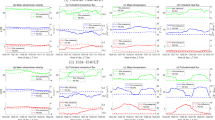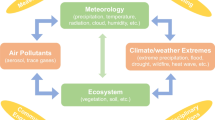Abstract
The complexities involved in the turbulent transport of \({\mathrm {CO}}_{2}\) in an urban area are investigated using data from a 40-m-tall flux tower located in suburban Salt Lake Valley, UT, USA. We found that the transport of \({\mathrm {CO}}_{2}\) in the urban inertial sublayer is very much influenced by non-local effects and conflicting mechanisms that resulted in the multi-scale transport of fluxes at disparate scales. During the day when the site acts as a net sink of \({\mathrm {CO}}_{2}\), positive fluxes are observed at the low frequency end of the vertical velocity \({\mathrm {CO}}_{2}\) cospectrum. This behaviour is in stark contrast to that of other scalars: water vapour and heat. We also found that, unlike forest and crop ecosystems, the urban \({\mathrm {CO}}_{2}\) (co)spectra (power spectra and cospectra) are characterized by multiple peaks and long plateaus. The analysis also found that large-scale advective processes influence the turbulent transport of \({\mathrm {CO}}_{2}\) during stable periods.












Similar content being viewed by others
References
Anderson D, Verma S (1985) Turbulence spectra of CO\(_2\), water vapor, temperature and wind velocity fluctuations over a crop surface. Bound-Layer Meteorol 33:1–14
Anderson D, Verma S, Clement R (1986) Turbulence spectra of CO\(_2\), water vapor, temperature and velocity over a deciduous forest. Agric For Meteorol 38:81–99
Andreas E, Hill R, Gosz J, Moore D, Otto W, Sarma A (1998) Statistics of surface-layer turbulence over terrain with metre-scale heterogeneity. Bound-Layer Meteorol 86:379–408
Arnfield A (2003) Two decades of urban climate research: a review of turbulence, exchanges of energy and water, and the urban heat island. Int J Climatol 23:1–26
Baldocchi D, Finnigan J, Wilson K, U KP, Falge E (2000) On measuring net ecosystem carbon exchange over tall vegetation on complex terrain. Bound-Layer Meteorol 96(1):257–291
Choi W, Faloona IC, McKay M, Goldstein AH, Baker B (2011) Estimating the atmospheric boundary layer height over sloped, forested terrain from surface spectral analysis during bearpex. Atmos Chem Phys 11:6837–6853
Christen A, van Gorsel E, Vogt R (2007) Coherent structures in urban roughness sublayer turbulence. Int J Climatol 27(14):1955–1968
Christen A, Rotach MW, Vogt R (2009) The budget of turbulent kinetic energy in the urban roughness sublayer. Bound-Layer Meteorol 131(2):193–222
Clarke J, Ching J, Godowitch J, Binkowski F (1987) Surface layer turbulence in an urban area. Tech. rep., Atmospheric Sciences Research Laboratory, U. S. Environmental Protection Agency
Coutts A, Beringer J, Tapper N (2007) Characteristics influencing the variability of urban CO\(_2\) fluxes in Melbourne, Australia. Atmos Environ 41(1):51–62
Feigenwinter C, Vogt R (2005) Detection and analysis of coherent structures in urban turbulence. Theor Appl Climatol 81(3):219–230
Feigenwinter C, Vogt R, Parlow E (1999) Vertical structure of selected turbulence characteristics above an urban canopy. Theor Appl Climatol 62(1–2):51–63
Feigenwinter C, Vogt R, Christen A (2012) Eddy covariance measurements over urban areas. In: Aubinet M, Vesala T, Papale D (eds) Eddy covariance. A practical guide to measurement and data analysis. Springer Atmospheric Sciences, Dordrecht, pp 377–397
Fitzjarrald D (1990) Atmospheric-biosphere exchange of CO\(_2\) and O\(_3\) in the central amazon forest. J Geophys Res 95:16,851–16,864
Goulden M, Munger J, Fan S, Daube B, Wofsy S (1996) Measurements of carbon sequestration by long-term eddy covariance: methods and a critical evaluation of accuracy. Global Change Biol 2(3):169–182
Grimmond C, Oke T (1999) Aerodynamic properties of urban areas derived from analysis of surface form. J Appl Meteorol 38(9):1262–1292
Grimmond CSB, King TS, Cropley FD, Nowak DJ, Souch C (2002) Local-scale fluxes of carbon dioxide in urban environments: methodological challenges and results from chicago. Environ Poll 116(1):S243–S254
Hanna SR, Chang JC (1992) Boundary-layer parameterizations for applied dispersion modeling over urban areas. Bound-Layer Meteorol 58(3):229–259
Hogstrom U, Smedman-Hogstrom AS (1974) Turbulence mechanism at an agricultural site. Bound-Layer Meteorol 7:373–389
Hollinger D, Kelliher F, Byers J, Hunt J (1994) Carbon dioxide exchange between an undisturbed old-growth temperate forest and the. Ecology 75(1):134–150
Kaimal J, Wyngaard J, Izumi Y (1972) Spectral characteristics of surface layer turbulence. Q J R Meteorol Soc 98:563–589
Kaimal JC, Finnigan JJ (1994) Atmospheric boundary layer flows: their structure and measurement. Oxford University Press Inc, New York, 289 pp
Kaimal JC, Gaynor JE (1991) Another look at sonic thermometry. Boundy-Layer Meteorol 56(4):401–410
Katul G, Hsieh C, Bowling D, Clark K, Shurpali N, Turnipseed A, Albertson J, Tu K, Hollinger D, Evans B (1999) Spatial variability of turbulent fluxes in the roughness sublayer of an even-aged pine forest. Bound-Layer Meteorol 93(1):1–28
Mahrt L, Vickers D (2002) Contrasting vertical structures of nocturnal boundary layers. Bound-Layer Meteorol 105:247–264
Moncrieff J, Valentini R, Greco S, Guenther S, Ciccioli P (1997) Trace gas exchange over terrestrial ecosystems: methods and perspectives in micrometeorology. J Exp Bot 48(5):1133
Moore C (1986) Frequency response corrections for eddy correlation systems. Bound-Layer Meteorol 37:17–35
Moriwaki R, Kanda M (2006) Similarity of turbulent transfers of heat, water vapor and carbon dioxide over a suburban surface under weakly unstable conditions. In: Sixth Symposium on the urban environment, American Meteorological Society
Nelson M, Pardyjak E, Klein P (2011) Momentum and turbulent kinetic energy budgets within the park avenue street canyon during the joint urban 2003 field campaign. Bound-Layer Meteorol 140:143–162
Ohtaki E (1985) Atmospheric fluctuations of carbon dioxide, water vapor and temperature over vegetated fields. Bound-Layer Meteorol 32:25–37
Oikawa S, Meng Y (1995) Turbulence characteristics and organized motion in a suburban roughness sublayer. Bound-Layer Meteorol 74(3):289–312
Panofsky H, Larko D, Lipschutz R (1982) Spectra of velocity components over complex terrain. Q J R Meteorol 105:215–230
Peters EB, McFadden JP (2012) Continuous measurements of net CO\(_2\) exchange by vegetation and soils in a suburban landscape. J Geophys Res-Atmos 117(G3):1–16
Ramamurthy P, Pardyjak ER (2011) Toward understanding the behavior of carbon dioxide and surface energy fluxes in the urbanized semi-arid salt lake valley, utah, usa. Atmos Environ 45(1):73–84
Raupach M, Finnigan J, Brunei Y (1996) Coherent eddies and turbulence in vegetation canopies: the mixing-layer analogy. Bound-Layer Meteorol 78(3–4):351–382
Rotach MW, Gryning SE, Batchvarova E, Christen A, Vogt R (2004) Pollutant dispersion close to an urban surface—the bubble tracer experiment. Meteorol Atmos Phys 87(1–3):39–56
Roth M (1993) Turbulent transfer relationships over an urban surface. II: Integral statistics. Q J R Meteorol Soc 119(513):1105–1120
Roth M (2000) Review of atmospheric turbulence over cities. Q J R Meteorol Soc 126:941–990
Roth M, Oke TR (1995) Relative efficiencies of turbulent transfer of heat, mass, and momentum over a patchy urban surface. J Atmos Sci 52(11):1863–1874
Roth M, Salmond J, Satyanarayana A, Christen A, Vogt R, Oke TR (2003) Turbulence characteristics, similarity and CO\(_2\) (co)spectra over an urban canopy. In: Fifth international conference on urban climate, pp 1–5
Salmond J, McKendry I (2005) A review of turbulence in the very stable nocturnal boundary layer and its implications for air quality. Prog Phys Geog 29:188–271
Salmond JA, Oke TR, Grimmond C, Roberts S, Offerle B (2005) Venting of heat and carbon dioxide from urban canyons at night. J Appl Meteorol 44(8):1180–1194
Smedman-Hogstrom AS (1973) Temperature and humidity spectra in the atmospheric surface layer. Bound-Layer Meteorol 3:329–347
Velasco E, Roth M (2010) Cities as net sources of CO\(_2\): review of atmospheric CO\(_2\) exchange in urban environments measured by eddy covariance technique. Geog Com 4(9):1238–1259
Velasco E, Pressley S, Allwine E, Westberg H, Lamb B (2005) Measurements of CO\(_2\) fluxes from the mexico city urban landscape. Atmos Environ 39(38):7433–7446
Vogt R, Christen A, Rotach MW, Roth M, Satyanarayana ANV (2006) Temporal dynamics of CO\(_2\) fluxes and profiles over a central european city. Theor Appl Climatol 84(1–3):117–126
Webb EK, Pearman GI, Leuning R (1980) Correction of flux measurements for density effects due to heat and water vapour transfer. Q J R Meteorol Soc 106(447):85–100
Weissert LF, Salmond JA, Schwendenmann L (2014) A review of the current progress in quantifying the potential of urban forests to mitigate urban CO\(_2\) emissions. Urban Climate 8:100–125
Wilzack J, Oncely S, Stage S (2001) Sonic anemometer tilt correction algorithms. Bound-Layer Meteorol 99:127–150
Acknowledgments
This material is based in part on work supported by the National Science Foundation under Grants ATM 0215768 and CBET 0828214. The authors would like to thank Jaikiran Sivasamudram, Dr Scott Speckart and Dr Holly Oldroyd for helping with the experiment.
Author information
Authors and Affiliations
Corresponding author
Rights and permissions
About this article
Cite this article
Ramamurthy, P., Pardyjak, E.R. Turbulent Transport of Carbon Dioxide over a Highly Vegetated Suburban Neighbourhood. Boundary-Layer Meteorol 157, 461–479 (2015). https://doi.org/10.1007/s10546-015-0074-0
Received:
Accepted:
Published:
Issue Date:
DOI: https://doi.org/10.1007/s10546-015-0074-0




